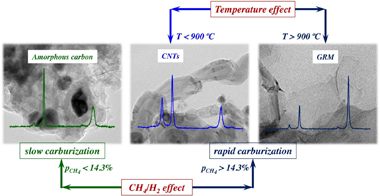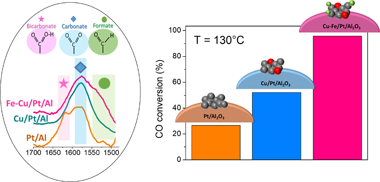Scientific Papers in SCI
2022
2022
Química de Superficies y Catálisis
Performance of AISI 316L-stainless steel foams towards the formation of graphene related nanomaterials by catalytic decomposition of methane at high temperature
Cazana, F; Latorre, N; Tarifa, P; Royo, CJ; Sebastian, V; Romeo, E; Centeno, MA; Monzon, ACatalysis Today, 383 (2022) 236-246
Show abstract ▽

This work explores the preparation of graphene-related materials (GRMs) grown on stainless steel foams via catalytic decomposition of methane (CDM). The main active phases for the reaction are the Fe nanoparticles segregated from the stainless-steel after the activation stage of the foam. The effect of the feed composition and reaction temperature has been studied in order to maximize the productivity, stability and selectivity to GRMs. The maximum productivity attained was 0.116 g(C)/g(foam) h operating at 950 degrees C with a feed ratio of CH4/H-2 = 3 (42.9 %CH4:14.3 %H-2). The carbonaceous nanomaterials (CNMs) obtained were characterized by X-Ray diffraction, Raman spectroscopy and by transmission and scanning electron microscopy. The parameters of the kinetic model developed are directly related to the relevant stages of the process, including carburization, diffusion-precipitation and deactivation-regeneration. The balance among these sequential stages determines the overall performance of the activated foam. In conditions of rapid carburization of the Fe NPs (p(CH4) > 14 %), the productivity to CNMs is favoured, avoiding an initial deactivation of the active sites by fouling with amorphous carbon. After a rapid carburization, the selectivity to the different CNMs is governed by the ratio CH4/H-2, and mainly by the temperature. Thus, the formation of GRMs, mainly Few Layer Graphene (FLG) and even graphene, is favoured at temperatures above 900 degrees C. At lower temperatures, carbon nanotubes are formed.
January, 2022 | DOI: 10.1016/j.cattod.2020.12.003
Química de Superficies y Catálisis
Unravelling the role of Fe in trimetallic Fe-Cu-Pt/Al2O3 catalysts for CO-PROX reaction
Palma, S; Gonzalez-Castano, M; Romero-Sarria, F; Odriozola, JAMolecular Catalysis, 517 (2022) 112015
Show abstract ▽

This work proposes a trimetallic Fe-Cu/Pt/Al2O3 catalyst as an appealing system for preferential oxidation of CO (CO-PROX) reaction. The excellent conversion rates achieved by the Fe-Cu/Pt/Al2O3 catalysts under realistic reforming-surrogated feed streams along with the catalyst stability, reproducibility, and scalability showcase a very competitive system for CO-PROX reaction units. Furthermore, the systematic analysis conducted for Pt/Al2O3, Cu/Pt Al2O3, and Fe-Cu/Pt/Al2O3 catalysts enabled establishing meaningful relationships between catalytic behaviour and the catalyst surface to reactants interactions. Thus, the enhanced CO oxidation performances attained by the incorporation of Fe species into bimetallic Cu/Pt/Al2O3 catalysts were associated to superior surface electron densities and inhibited CO adsorption process over Pt surfaces. Remarkably, operando-DRIFTS spectroscopy evidenced significantly larger H-containing surface species developed over the trimetallic system. The enhanced abilities for developing thermally instable intermediates favoured by small amounts of Fe should indeed determine the enhanced catalysts behaviours displayed by the trimetallic Fe-Cu/Pt/Al2O3 catalyst.
January, 2022 | DOI: 10.1016/j.mcat.2021.112015
Reactividad de Sólidos
Flash Sintering Research Perspective: A Bibliometric Analysis
Gil-Gonzalez, E; Perez-Maqueda, LA; Sanchez-Jimenez, PE; Perejon, AMaterials, 15 (2022) 416
Show abstract ▽
Flash Sintering (FS), a relatively new Field-Assisted Sintering Technique (FAST) for ceramic processing, was proposed for the first time in 2010 by Prof. Rishi Raj's group from the University of Colorado at Boulder. It quickly grabbed the attention of the scientific community and since then, the field has rapidly evolved, constituting a true milestone in materials processing with the number of publications growing year by year. Moreover, nowadays, there is already a scientific community devoted to FS. In this work, a general picture of the scientific landscape of FS is drawn by bibliometric analysis. The target sources, the most relevant documents, hot and trending topics as well as the social networking of FS are unveiled. A separate bibliometric analysis is also provided for Reaction or Reactive Flash Sintering (RFS), where not only the sintering, but also the synthesis is merged into a single step. To the best of our knowledge, this is the first study of this nature carried out in this field of research and it can constitute a useful tool for researchers to be quickly updated with FS as well as to strategize future research and publishing approaches.
January, 2022 | DOI: 10.3390/ma15020416
Nanotecnología en Superficies y Plasma - Tribología y Protección de Superficies
Compositional gradients at the nanoscale in substoichiometric thin films deposited by magnetron sputtering at oblique angles: A case study on SiOx thin films
Garcia-Valenzuela, A; Alcaide, AM; Rico, V; Ferrer, FJ; Alcala, G; Rojas, TC; Alvarez, R; González-Elipe, AR; Palmero, APlasma Processes and Polymers (2022) e2100116
Show abstract ▽
We demonstrate the existence of stoichiometric variations at the nanoscale when growing nanocolumnar SiOx thin films by reactive magnetron sputtering deposition at oblique angles. Results show stoichiometric variations in the range 0.3 < x < 1.3 when growing a SiO0.5 thin film. This agrees with results from a numerical growth model that obtains a shift of the stoichiometry in all nanocolumns from lower values at the side facing the Si target to higher values at the opposite side. The different momentum distribution of the gaseous reactive and sputtered species results in preferential incorporation of the latter at a particular side of the nanocolumns. The general occurrence of this mechanism during the reactive magnetron sputtering deposition of substoichiometric thin films at oblique angles is discussed.
January, 2022 | DOI: 10.1002/ppap.202100116
2021
2021
Materiales de Diseño para la Energía y Medioambiente
Mechanical Performances of Isolated Cuticles Along Tomato Fruit Growth and Ripening
Benitez, JJ; Guzman-Puyol, S; Vilaplana, F; Heredia-Guerrero, JA; Dominguez, E; Heredia, AFrontiers in Chemistry, 12 (2021) 787839
Show abstract ▽
The cuticle is the most external layer that protects fruits from the environment and constitutes the first shield against physical impacts. The preservation of its mechanical integrity is essential to avoid the access to epidermal cell walls and to prevent mass loss and damage that affect the commercial quality of fruits. The rheology of the cuticle is also very important to respond to the size modification along fruit growth and to regulate the diffusion of molecules from and toward the atmosphere. The mechanical performance of cuticles is regulated by the amount and assembly of its components (mainly cutin, polysaccharides, and waxes). In tomato fruit cuticles, phenolics, a minor cuticle component, have been found to have a strong influence on their mechanical behavior. To fully characterize the biomechanics of tomato fruit cuticle, transient creep, uniaxial tests, and multi strain dynamic mechanical analysis (DMA) measurements have been carried out. Two well-differentiated stages have been identified. At early stages of growth, characterized by a low phenolic content, the cuticle displays a soft elastic behavior. Upon increased phenolic accumulation during ripening, a progressive stiffening is observed. The increment of viscoelasticity in ripe fruit cuticles has also been associated with the presence of these compounds. The transition from the soft elastic to the more rigid viscoelastic regime can be explained by the cooperative association of phenolics with both the cutin and the polysaccharide fractions.
December, 2021 | DOI: 10.3389/fpls.2021.787839
- ‹ previous
- 62 of 411
- next ›














